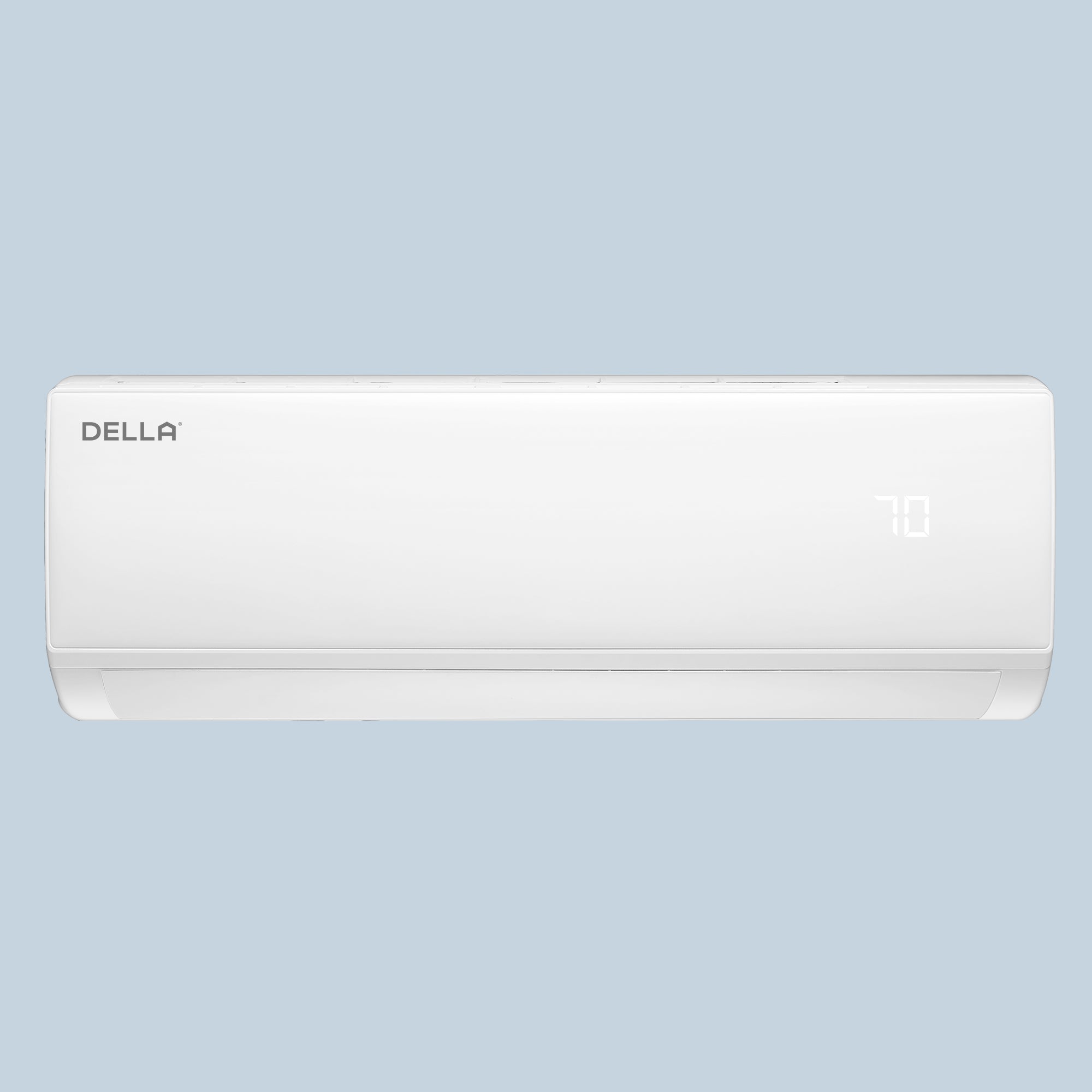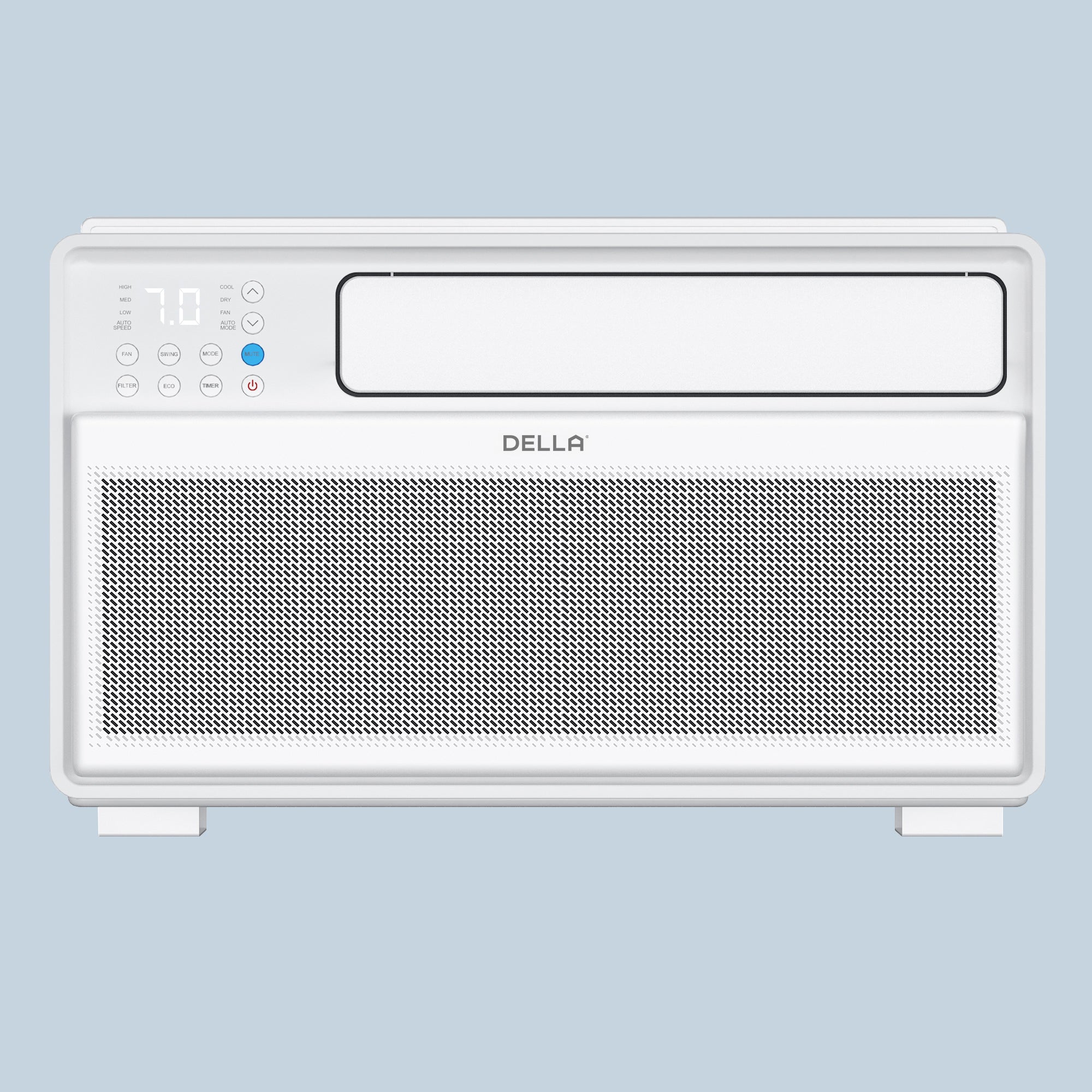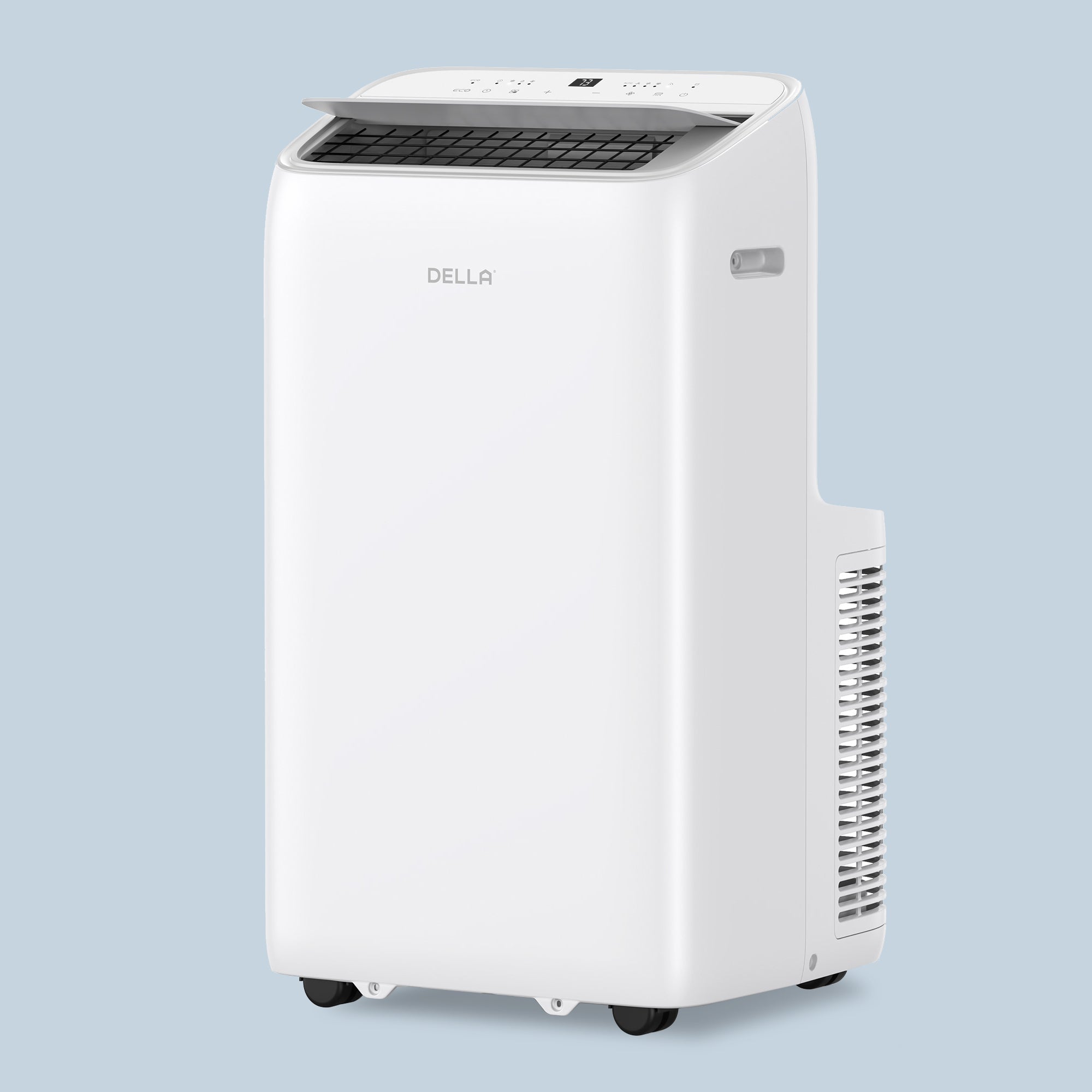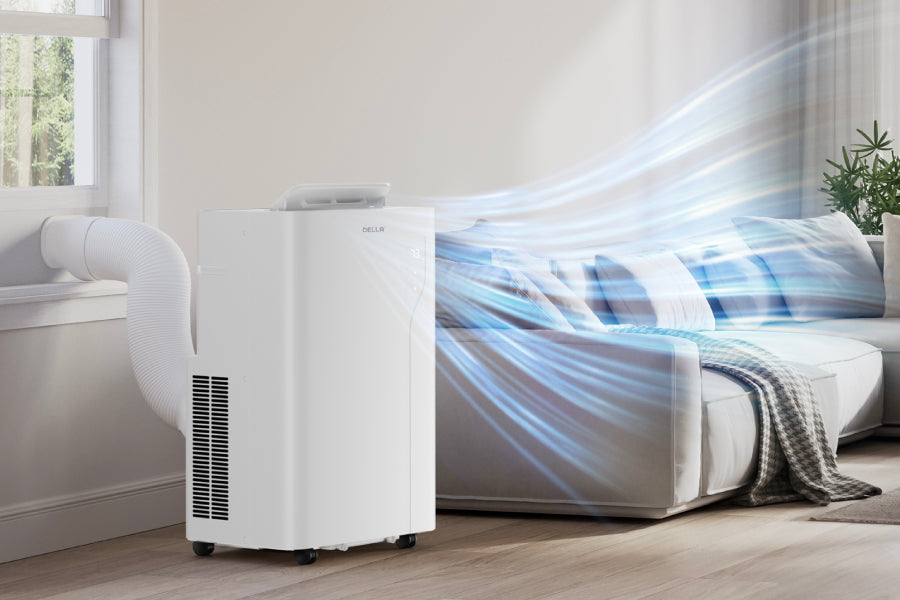Portable air conditioners are also a great pick for spaces where you can’t install permanent air conditioning units as they require structural modification. These air conditioners are most popular for small spaces like attics, RVs, and home offices where regular air conditioners are not viable.
While portable air conditioners offer a range of benefits, if you’re investing in one, you would want to know how they work. This article covers how portable air conditioners work. It also addresses the sizing, weighs the pros and cons, and a short buying guide on portable ACs to help you choose your first portable air conditioner.
What is a portable air conditioner?
Portable air conditioners are versatile, self-contained cooling units that are designed for easy mobility with wheels on its bottom. They come in an all-in-one package, meaning installation is easy and doesn’t require any structural changes to the space. They just require a power outlet and a window opening to vent out the warm air.
How Does a Portable Air Conditioner Work?
The mechanism of portable air conditioners is similar to fixed air conditioners. They function by extracting warm air from a room, cooling it, and then recirculating the cooled air back into space.
Portable Air Conditioner Mechanism
Here is the process through which portable air conditioners cool the air. The process is broken down into four steps for a simple explanation:
Step 1 - Air Intake
A fan draws warm, humid air from the room into the unit. If it is a single hose system, there’s only one fan to draw the humid air from the room and expel the heat outside. If it is a dual-hose system, there are two separate hoses for drawing the air from the room and expelling the warm air outside.
Step 2 - Cooling Process
Once the air is collected, the compressor begins working. It raises the temperature of the refrigerant by pumping it through the evaporator coils. This process allows the refrigerant to absorb heat from the air drawn in the first step. As the air cools, moisture condenses into water, helping dehumidify the space.
Step 3 - Air Recirculation
The cooled, dehumidified air is then blown back into the room using the in-built fan. This helps lower the overall temperature in the room.
Step 4 - Heat and Moisture Exhaust
The heat absorbed by the refrigerant in the second step proceeds to be expelled through an exhaust hose. In a portable air conditioner, this is connected to a window or vent. The unit also manages moisture drainage through self-evaporation, manual draining, or a continuous drain hose.
The cycle continues till the room's humidity is lowered and the temperature reaches the temperature on the thermostat.

Single-Hose vs. Dual-Hose Models
If you’ve browsed through portable air conditioners in-store or online, you’d know that they come in two primary configurations. Here’s a short description of both these configurations:
-
Single-Hose Units: Utilize one hose for both air intake and exhaust. While these units are simpler to install than dual-hose units, they can create negative pressure in the room. This means that any warm air infiltration from adjacent areas such as door cracks or even window cracks may reduce the unit’s cooling efficiency.
-
Dual-Hose Units: As evident by the name, dual hose units feature separate hoses for intake and exhaust. This design prevents negative pressure, allowing for more efficient cooling. These units are great for larger spaces or hotter environments.
Water Drainage in Portable Air Conditioners
As the air conditioner cools the air, it also removes humidity, which condenses into water inside the unit. Different portable air conditioners drain water in various ways:
-
Self-Evaporating Units: These models automatically evaporate and expel most of the collected moisture through the exhaust hose, reducing the need for manual draining.
-
Partial Evaporation Models: Some moisture is evaporated, but in humid environments, excess water may need to be drained manually.
-
Fully Drainable Models: These units collect water in an internal reservoir or require a continuous drain hose to remove water automatically.
Heat Pump Functionality
Some portable air conditioners are designed as heat pumps, meaning they can provide both cooling and heating. Della’s portable air conditioners offer this dual functionality too. In cooling mode, they remove heat from the room and expel it outside. In heating mode, they work in reverse, extracting heat from the outside air and transferring it indoors.
Heat pump portable air conditioners are energy-efficient and cost-effective options for enjoying temperature control all year round.
What Size Of A Portable Air Conditioner Is Needed For My Room?
Selecting an appropriately sized portable air conditioner is crucial for effective cooling. The unit's cooling capacity is measured in British Thermal Units (BTUs), and the required BTU rating depends on the room's size.
To know what size of portable air conditioners you need, follow these steps:
-
Start by measuring your room's square footage (length × width).
-
Calculate the BTU by the formula: BTU = square foot × 20. For
-
Adjust the BTU for these factors:
- +10% BTU if your room ceilings are over 8 feet high
- +10% for your room is exposed in the strong sunlight
- +20% for your room has poor insulation
Here is a chart that outlines the recommended BTUs according to the room’s size:
|
Room Size (Square Feet)
|
Recommended BTUs
|
|
up to 150
|
5,000
|
|
150 - 250
|
6,000
|
|
250 - 300
|
7,000
|
|
300 - 350
|
8,000
|
|
350 - 400
|
9,000
|
|
400 - 450
|
10,000
|
|
450 - 550
|
12,000
|
|
550 - 700
|
14,000
|
|
700 - 1,000
|
18,000
|
|
1,000 - 1,400
|
24,000
|
Are portable air conditioners worth it?
Even though portable air conditioners are a revolutionary technology, before you make a purchase, you might want to weigh its pros and cons compared to a permanently installed air conditioning unit. We’ve made it easy for you by outlining the pros and cons for you:
Pros
-
Mobility: The best part about portable air conditioners is that they can be easily moved between rooms as needed.
-
Ease of Installation: No permanent installation is required with portable air conditioners and the setup is fairly straightforward. So, you won’t need professional help to install a portable air conditioner in your room.
-
Flexibility: Portable air conditioners are ideal for cooling specific areas without affecting the entire home.
Cons
-
Energy Efficiency: Because these units have everything built into a single, compact unit, they are generally less efficient than window units. This might mean a higher energy consumption.
-
Noise Levels: Portable units can be noisier since all components are housed within the room.
-
Space Occupation: They occupy floor space, which might be a problem in smaller rooms.
Considering these factors, portable air conditioners are a viable option for those seeking temporary or supplemental cooling solutions. They are also great for rental housing units, RVs, or outhouses where installing permanent air conditioning is not an option.
How to Choose the Best Portable Air Conditioner for Your Needs?
Selecting the right portable air conditioner requires careful consideration of four key factors to ensure efficient cooling and a comfortable user experience:
1. Match the Unit to Your Room Size
Refer to the BTU chart provided earlier to determine the appropriate cooling capacity. Oversizing your portable air conditioners will cause frequent turning on or off and high electric bills, while undersizing will make your portable AC work harder to achieve the desired temperature.
2. Energy Efficiency Impacts Long-Term Costs
Look for models with a SEER (Seasonal Energy Efficiency Ratio) of at least 12. SEER measures the cooling output divided by the energy consumed over a typical cooling season—the higher the SEER, the more energy-efficient the unit.
For instance, an 14,000 BTU air conditioner with a SEER of 12 consumes approximately 667 watts, while a SEER 14 model uses only 571 watts. Over a summer season, the higher SEER unit can save you around $20 in electricity costs (based on 8 hours of daily use and 0.12 per kWh).

3. Noise Levels Affect Comfort
For bedrooms or study areas, choose a unit with a noise level of ≤50 decibels (comparable to light rainfall). In living rooms or kitchens, a noise level of ≤55 decibels (similar to normal conversation) is acceptable. Be cautious of manufacturers that only advertise the lowest fan speed noise—always check the maximum fan speed noise level to avoid unpleasant surprises.
4. Additional Features for Enhanced Convenience
-
Dehumidification: In humid climates, opt for a unit with a daily dehumidification capacity of at least 30 liters, which can reduce indoor humidity from 80% to below 50%.
-
Smart Controls: Models with WiFi or voice control capabilities allow you to remotely turn on the unit 15 minutes before arriving home, ensuring a cool environment when you walk in.
-
Self-Evaporative Systems: Units with self-evaporative technology can run for 7 days or more without manual drainage, making them ideal for extended use.
Best Portable Air Conditioners in 2025
When selecting a portable air conditioner, it's essential to choose a model that aligns with your specific needs and space requirements. Della offers a diverse range of portable air conditioners designed to cater to various preferences. Here are some top recommendations:
Smallest Model
For those seeking a compact solution, the DELLA 8,000 BTU Portable Air Conditioner is an excellent choice. Designed for rooms up to 350 sq. ft., this unit provides efficient cooling while maintaining a minimal footprint, making it ideal for smaller spaces or areas with limited floor space.
Ideal for Bedrooms
Creating a comfortable sleeping environment requires a balance of cooling power and quiet operation. The DELLA 12,000 BTU Portable Air Conditioner with Dehumidifier Function offers this balance, providing sufficient cooling for medium-sized rooms while operating quietly to ensure restful sleep. Its dehumidifier function also helps maintain optimal humidity levels, enhancing overall comfort.
Quietest Operation
Noise-sensitive environments benefit from air conditioners designed for quiet performance. The DELLA 14,000 BTU Inverter Ultra Quiet Portable AC is engineered to operate at lower noise levels. It is perfect for spaces where minimal disruption is essential, such as home offices or study areas.
Suitable for Living Rooms
Living rooms often require powerful cooling due to their larger size and frequent gatherings. The DELLA Velocity Series 14,000 BTU Smart WiFi Enabled Portable AC is designed to cool areas up to 650 sq. ft., making it perfect for spacious living rooms. Its smart WiFi capabilities allow for convenient control via the Della app, enhancing user experience.
For Camping and RV Use
Portability and energy efficiency are crucial for outdoor and mobile applications. While Della offers a range of portable air conditioners, it's important to consider the power availability and space constraints typical of camping and RV setups.
Models like the DELLA 10,000 BTU Portable Air Conditioner are compact and efficient, potentially suitable for such uses. However, it's recommended to consult with Della's customer service to ensure compatibility with your specific camping or RV setup.

Conclusion
Portable air conditioners are a versatile and practical solution for cooling spaces where traditional units are not feasible. Whether you’re looking to cool a small bedroom, a spacious living room, or even an RV, choosing the right unit ensures comfort and efficiency.
Ready to enjoy a cooler, more comfortable space? Explore Della Home’s wide range of portable air conditioner for small room, designed to deliver reliable performance and innovative features. With easy installation, smart controls, and energy-efficient designs, Della has the ideal unit for every home. Visit Dellahome today and take the first step toward beating the heat with confidence!
FAQs
Do any portable air conditioners work without a window?
Yes, some portable air conditioners can operate without a window, but they still need a way to vent hot air, such as through a door, wall, or drop ceiling. Ventless air coolers, like evaporative (swamp) coolers, do not require exhaust but work best in dry climates by adding moisture to the air. If a traditional portable AC is used without proper venting, it will not effectively cool the room and may even make it warmer.
Do windowless air conditioners really work?
Windowless air conditioners, such as evaporative coolers, work by using water to cool and humidify the air, making them effective in hot, dry regions but less so in humid environments.
They do not actively remove heat like a traditional AC unit, so they won’t lower room temperature in the same way. If used correctly in the right climate, they can provide comfort, but they are not a full replacement for a standard air conditioner.
Read More:
How To Vent A Portable AC Without A Window?
Best Portable Air Conditioners | Top Picks in 2024
How to Clean a Portable AC: Step-by-Step Cleaning Guide
How to Fix and Prevent Frozen Evaporator Coils in Your AC?
Why Is My Air Conditioner Fan Not Working? Fix & Maintain Guide









LEAVE A COMMENT
All comments are moderated before being published.
This site is protected by hCaptcha and the hCaptcha Privacy Policy and Terms of Service apply.